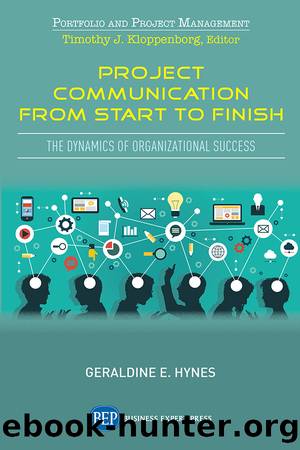Project Communication from Start to Finish by Geraldine E. Hynes

Author:Geraldine E. Hynes [Geraldine E. Hynes]
Language: eng
Format: epub
Publisher: Business Expert Press
Published: 2019-06-12T16:00:00+00:00
Define the problem
Analyze the problem
Brainstorm solutions
Develop criteria for a good solution
Find the best match
Follow up
Here are the six steps in the collaboration process:
Define the problem. The problem definition must be specific. Stating the problem in a conflict situation is usually much more difficult than it seems, and most people jump to solutions before they clearly define the problem. Because of this, our inclination is to state the problem as a solution rather than as a goal, which results in ambiguous communication. The outcome may be increased conflict. One helpful strategy is to write out the problem statement clearly, so everyone can see it and agree on it. Or you can agree on a problem stated as a question. State goals in the form of team goals rather than your own goals.
Analyze the problem. Again, most people want to skip this step. After all, they may argue, they live with the problem. What is the point of spending more time wallowing in it? The answer is that by exploring the depths of the problem, by looking at its history, causes, effects, and extent, you can later come up with a solution that addresses more than symptoms, one that is more than a bandage. This analysis step will uncover the root cause of the problem, thus improving the chances of being successful.
Brainstorm alternatives. Everyone involved in the conflict should offer potential solutions. One idea may stimulate other ideas. The more you communicate in an open, trusting environment, the greater the potential for finding effective solutions. Trust, of course, evaporates when an idea is criticized during a brainstorming session. As soon as someone says, “That’s a terrible idea. It’ll never work,” who would be willing to take the risk of coming up with another idea? Make sure that you don’t judge ideas prematurely.
Develop criteria for a good solution. These criteria, or standards, may already be in place and available. Occasionally, you and your team are allowed to develop your own criteria. It is important to delay developing the list of criteria until after step 3, brainstorming, has been completed. Otherwise, the identification of alternatives could be stymied by the group’s preconceived evaluations. The most common criteria for a good solution are:
Download
This site does not store any files on its server. We only index and link to content provided by other sites. Please contact the content providers to delete copyright contents if any and email us, we'll remove relevant links or contents immediately.
| Ethics | Etiquette |
| Fashion & Image | Health & Stress |
| Motivation & Self-Improvement | Work Life Balance |
| Workplace Culture |
Tools of Titans by Timothy Ferriss(8186)
Change Your Questions, Change Your Life by Marilee Adams(7610)
Deep Work by Cal Newport(6855)
Man-made Catastrophes and Risk Information Concealment by Dmitry Chernov & Didier Sornette(5900)
Playing to Win_ How Strategy Really Works by A.G. Lafley & Roger L. Martin(5865)
Digital Minimalism by Cal Newport;(5633)
Big Magic: Creative Living Beyond Fear by Elizabeth Gilbert(5577)
The Slight Edge by Jeff Olson(5335)
Ego Is the Enemy by Ryan Holiday(5267)
The Motivation Myth by Jeff Haden(5143)
Stone's Rules by Roger Stone(5013)
The Laws of Human Nature by Robert Greene(4969)
Tuesdays with Morrie by Mitch Albom(4663)
Eat That Frog! by Brian Tracy(4411)
Rising Strong by Brene Brown(4363)
Skin in the Game by Nassim Nicholas Taleb(4144)
Bullshit Jobs by David Graeber(4068)
The Money Culture by Michael Lewis(4052)
Skin in the Game: Hidden Asymmetries in Daily Life by Nassim Nicholas Taleb(3907)
